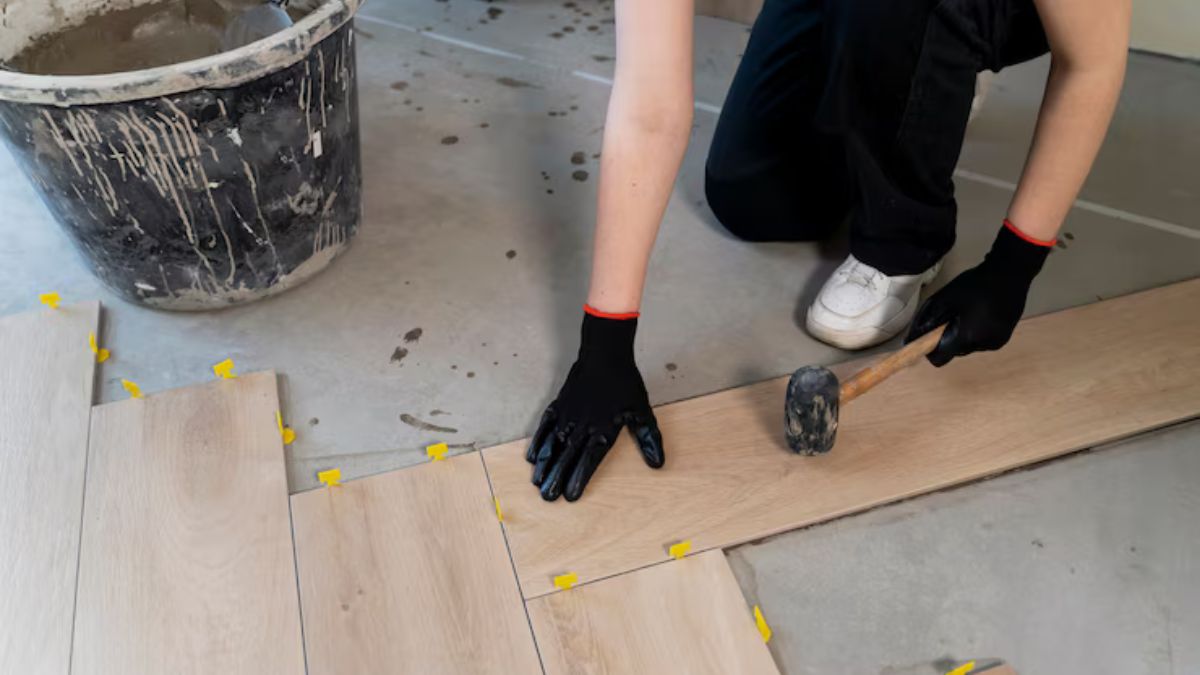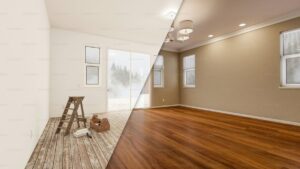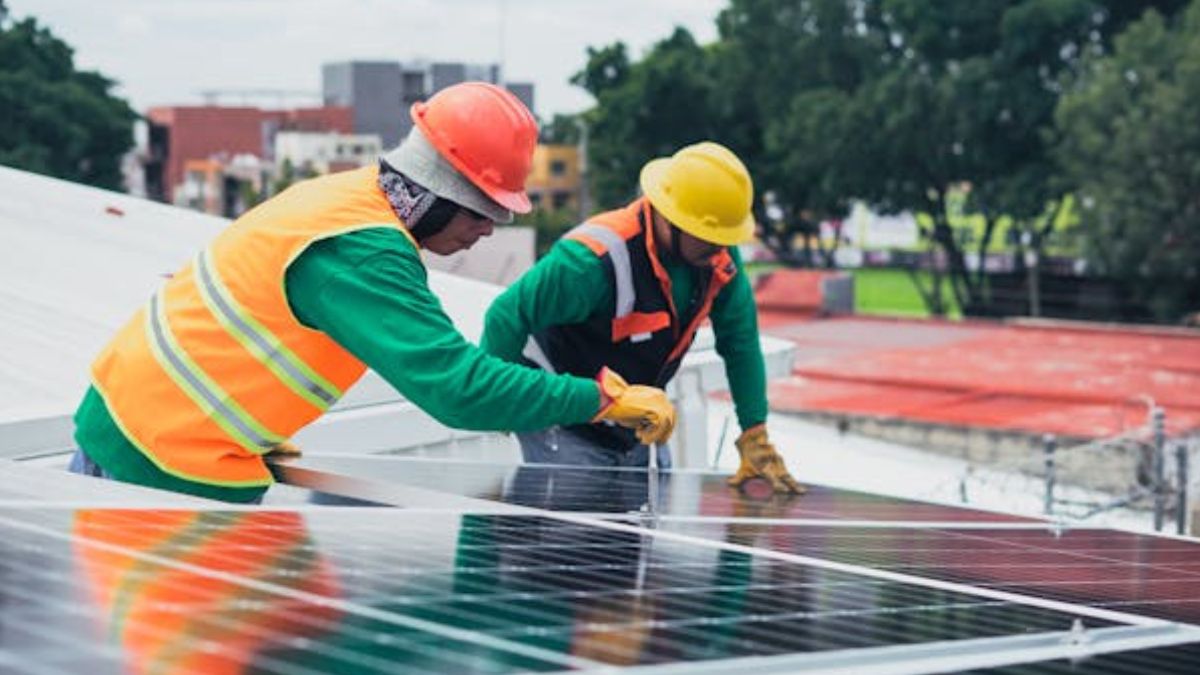CONSTRUCTION
Flooring Installation Cost Guide (2024)

Undertaking a flooring installation project will call for a delicate balancing act between what seems beautiful, durability needs, and most importantly, budgetary consideration. With that in mind, this full guide by Volcano Builders seeks to make light of the myriad cost factors and influences intrinsic to a set of flooring installation services. Whether you’re considering luxurious warmth with hardwood or practical appeal with laminate, remember that it’s realizing the expenditure to make an informed choice commensurate with your vision and your wallet.

Flooring Installation Cost Per Square Foot
The average cost of flooring, per square foot, can be so different, considering the material used. These measurements will give a base for making the budget, but still, always be considered that the total expenses can vary due to the complexity of the installation and geographic location, among others.
Cost by Flooring Type
Hardwood
Hardwood floors are a timeless choice that add warmth and character to any space. However, they come with a higher price tag, typically ranging from $6 to $12 per square foot, with some premium types exceeding $12. This cost includes both the material and installation charges. Hardwood is prized for its durability and longevity, but the initial investment is significant.
Tile
Tile flooring offers versatility and durability, making it ideal for areas prone to moisture, such as bathrooms and kitchens. The cost for tile flooring can range from $1 to $15 per square foot, heavily depending on the material (ceramic, porcelain, stone). High-end tiles can cost more, especially if you opt for custom designs or premium materials.
Carpet
Carpet is known for its comfort and softness, making it a popular choice for bedrooms and living areas. The cost of carpet installation can vary from as low as $0.65 to more than $12 per square foot, depending on the quality and type of carpet chosen. Synthetic carpets tend to be more affordable, while natural fibers like wool can be on the higher end.
Vinyl
Vinyl flooring, including luxury vinyl plank (LVP) and luxury vinyl tile (LVT), offers a cost-effective and resilient option. Prices can range from $1 to $7 per square foot. Vinyl is appreciated for its water resistance and ease of installation, making it a budget-friendly choice for many homeowners.
Laminate
Laminate flooring provides the look of hardwood or stone at a fraction of the cost, ranging from $0.50 to $5 per square foot. It is durable, easy to maintain, and simple to install, making it a great option for those looking to save on installation costs.
Linoleum
Linoleum is a natural, eco-friendly flooring option that ranges from $2 to $5 per square foot. It is durable and offers a variety of colors and patterns, making it a versatile choice for any room.
Bamboo
Bamboo flooring is known for its strength, durability, and eco-friendliness. The cost can vary from $2 to $8 per square foot. Bamboo offers a unique look and is often considered a more sustainable alternative to hardwood.
Cork
Cork flooring is another eco-friendly option, providing a soft, cushioned feel underfoot. Prices for cork flooring range from $2 to $8 per square foot. Cork is valued for its natural thermal and acoustic insulating properties.
Concrete
Polished concrete flooring is gaining popularity for its modern look and durability. The cost can range from $2 to $6 per square foot for basic polishing. Additional finishes and colors can increase the cost. Concrete is ideal for industrial-style homes and is incredibly long-lasting.
Labor Cost for Floor Installation
The labor cost for flooring installation can vary as much as the materials themselves. Professional services, such as those provided by Volcano Builders, ensure precision and efficiency but can significantly impact your overall budget. Discussing your project with a professional can help tailor the installation to your financial and aesthetic needs.
Factors That Affect Flooring Costs
Your actual total flooring project cost can be much higher with several important factors that include the size and shape of room(s), the condition of the existing subfloor, and special patterns or designs of installation.
How Much Does It Cost to Install Floors Yourself?
Laying your own floor is a great DIY project and can be a very good way to save on labor charges, but be clear in your understanding of the financial implications and commitments. When it comes to floor installation services, most companies speak of their professionalism and how they are prompt in service, such as with Volcano Builders. But for those people who want to do everything by themselves, here is an overview of the itemized costs and clear factors when it comes to flooring installations done by themselves.
Initial Investment in Tools and Equipment
First off, there are the expenses on indispensable tools and equipment, which would vary with the kind of flooring. The basic tools include a hammer, saw, tape measure, and trowel. These might cost somewhere from $50 to $200. The tools designed for flooring work can increase these costs by a lot: potentially up to $500 or more if you need to purchase everything from scratch.
Underlayment and Supplies
Also, don’t forget to include the cost for underlayment, adhesives, and finishing supplies. Underlayment would be from $0.30 to $0.60 per square foot, adhesives and finishes would be charged to your account for any type of floor, which would be from $0.50 to $1.50 per square foot on top of your whole expenses.
Potential Savings and Costs
Although you stand to save a lot on labor by doing it yourself—some laminate labor costs can run from $1.50 to $5 per square foot or more, depending on the complexity and type of flooring—mistakes made could mean more money out of your pocket. This could involve incorrect measurements, wastage of materials, and even the possibility of re-buying supplies or hiring a professional to correct any mistakes. Doing your own DIY flooring installation could also mean huge savings on labor, in that the full cost of your project would be approximately halved if completed by a professional. A moderately sized room for DIY installation could save you anywhere from $500 to several thousand dollars. That said, one must weigh these savings against tooling costs and run the chance of more expensive material—not to mention risking expensive mistakes. Proper planning, research, and preparation will help reduce these risks and turn the installation of your floor into a rewarding and cost-effective do-it-yourself project.

Ways to Save on Flooring Installation Costs
If you’re contemplating updating your floors, it’s entirely possible to do so without exhausting your budget. Here are several strategies to economize on flooring updates, from installing tile or hardwood floors to rejuvenating your current carpet.
Remove Old Flooring
Initiate the process by tackling some preparatory tasks before bringing in a professional. By taking out the old flooring on your own, you might cut costs by as much as $3.50 per square foot. This step is advisable only if you’re confident in preserving the condition of the subfloor beneath.
Move Furniture Yourself
Contribute to the effort by handling some of the labor-intensive tasks on your own. Enlist the help of a friend to relocate furniture and vacate the space earmarked for the new floor, which can be a cost-effective alternative to paying a professional team for the service.
Balance Price and Quality of Materials
While deciding the material of your floor, consider the cost and quality of the materials, as one is very tempted at first to go for the cheapest, but it may require replacing much earlier than expected. Opt for materials that strike a balance between affordability and quality to ensure savings on both the installation and future maintenance.
Flooring installation presents a spectrum of costs and considerations. By partnering with Volcano Builders for your flooring installation services, you can navigate these complexities with ease, ensuring a result that meets your expectations both visually and financially. Remember, thoughtful planning and a balanced approach to material selection and labor can transform your space without undue strain on your budget.
CONSTRUCTION
Ways to pay for emergency home repairs

We’ve all been there – that unexpected moment when something in your home breaks down. One minute, everything is fine, and the next, you’re facing a major emergency repair. Whether it’s a busted furnace, a leaking roof, or a dead air conditioning unit in the middle of summer, these expenses can feel like financial punches that come out of nowhere. Water heater issues? Not too bad, right? A few hundred bucks, and you’re back to hot showers. But the larger expenses, like replacing a furnace or dealing with roofing issues, can throw a serious wrench in your budget. So, how do you cover those hefty costs? Here are several ways to finance emergency home repairs, and some of them might surprise you.
Look Into a Personal Loan
One of the most common ways to cover emergency home repairs is through a personal loan. If you have good credit, you might be able to borrow a lump sum of money from a bank or credit union. Personal loans are often unsecured, meaning you don’t have to put up your house or other assets as collateral, which makes them a safer option than some other loans. However, keep in mind that interest rates can vary depending on your credit score, so it’s important to shop around for the best rates.
Personal loans usually have a fixed repayment term, so you’ll know exactly how much you’ll owe each month. While this can help you budget and avoid surprise payments, it’s important to ensure you can afford the monthly payments before taking on this type of loan.
Home Equity Line of Credit (HELOC)
If you own your home and have built up some equity, a Home Equity Line of Credit (HELOC) might be an option for covering major repairs. This type of loan works similarly to a credit card: you’re given a credit limit, and you can borrow what you need, when you need it. The major difference is that a HELOC is secured by your home, so there is a risk if you fail to repay the loan.
While a HELOC can have lower interest rates than personal loans, it also requires you to use your home as collateral, which means you could risk losing your house if you can’t repay the loan. Make sure you can comfortably manage the payments before choosing this route.
Credit Cards: Not Always the Best, but an Option
Credit cards are often seen as a last resort for emergency expenses. That’s because interest rates on credit cards can be sky-high, especially if you carry a balance month-to-month. However, if you need to make a repair immediately and you have a credit card with a decent limit and a relatively low interest rate, it could be a quick fix.
Some credit cards also offer introductory 0% APR for a certain period, which can be a great option if you’re confident you can pay off the balance before the interest kicks in. However, if you can’t pay off the debt in time, the interest will hit hard, and you could end up paying far more than you initially borrowed.
Government Grants or Assistance Programs
For certain home repairs, especially those that affect your safety and health, there may be government assistance programs available. These programs are typically aimed at low-income homeowners or those who are elderly or disabled. For example, the U.S. Department of Housing and Urban Development (HUD) offers programs like the Section 504 Home Repair Program, which provides grants and loans to help homeowners make necessary repairs.
It’s worth doing some research to see if you qualify for any local, state, or federal programs. These grants and loans often don’t need to be repaid or come with very low-interest rates, making them a great option if you meet the eligibility requirements.
Home Repair Financing Through Contractors
Some contractors offer financing options for big repairs, like replacing your roof or furnace. These financing plans can be a good way to spread the cost of the repair over time, and some contractors offer interest-free financing for a set period. It’s a way to get the work done immediately without having to come up with all the money upfront.
However, it’s important to read the fine print carefully. If the financing offer seems too good to be true, it might come with hidden fees or extremely high-interest rates once the introductory period ends. Always do your homework and compare contractor financing with other available options to ensure it’s the best deal for your situation.
Homeowners Insurance
If the damage to your home is caused by a covered event (like a fire, storm, or vandalism), your homeowners insurance policy might cover some or all of the costs of repairs. Keep in mind that insurance will typically cover the repair or replacement of the damaged item (like a roof or furnace) after you meet your deductible.
For emergency repairs, homeowners insurance can be a life-saver, but it’s not always a guarantee that every issue will be covered. For example, if your furnace breaks down due to normal wear and tear, insurance is unlikely to cover the repair. It’s important to check your policy and contact your insurer to understand what’s covered in these situations.
DIY or Temporary Fixes
Sometimes, the best way to deal with an emergency home repair is to take a step back and assess the situation. Can you temporarily patch things up until you have enough funds to do a full repair? This is especially true for issues like plumbing leaks or roof damage. While it’s not a long-term solution, a temporary fix can buy you some time and allow you to save money for a permanent repair.
If you’re handy around the house, you might be able to tackle some minor repairs yourself. Fixing a leaky faucet or patching up a small hole in the roof could save you hundreds of dollars in labor costs. However, be careful about tackling larger, more complicated repairs unless you’re fully confident in your skills.
Final Thoughts
Emergency home repairs can be a real financial burden, but there are several ways to cover the costs without completely breaking the bank. Whether you’re considering a personal loan, using a credit card, tapping into your home equity, or applying for government grants, it’s important to weigh your options carefully and make sure you choose the one that best fits your financial situation.
Before making a decision, take a moment to assess your ability to repay the loan or credit, and explore any options that could help you minimize costs, such as government assistance or contractor financing. While home repairs are never welcome, with the right plan, you can get your home back in shape without causing financial strain.
CONSTRUCTION
Sustainable Roofing Solutions: Innovations and Practices in Commercial Roofing

As the demand for environmentally friendly construction grows, the roofing sector is experiencing a considerable change. Nowadays, commercial roofing isn’t just about protection but innovation and sustainability. Modern roofing approaches focus on reducing energy consumption, enhancing building aesthetics, and improving the urban environment. From minimizing energy bills to lessening urban heat, sustainable roofing practices are shaping the future of our cities and businesses, making them more livable and efficient.
This guide delves into the various aspects of sustainable roofing solutions. Whether you are a business owner contemplating a roof replacement or an architect interested in the latest roofing trends, you’ll find valuable insights here. By exploring cutting-edge technologies, materials, and best practices that align with the growing environmental consciousness, it becomes clear how impactful these strategies can be. In an era where climate change is at the forefront of agendas, investing in sustainable roofing offered by a roofing company is not just an option; it’s an imperative.
Introduction to Sustainable Roofing
Sustainable roofing encompasses various materials and practices designed to minimize environmental impact. It includes using recycled materials, improving energy efficiency, and implementing innovative technologies. With buildings accounting for a significant amount of energy and resource use, the importance of sustainability cannot be overstated. These approaches help conservation efforts and lead to long-term savings and a healthier environment, contributing to a larger initiative in addressing climate change and resource depletion.
The Benefits of Green Roofs
Green roof roofs play a critical role in urban biodiversity, creating habitats for various species of birds, insects, and plants. They also enhance air quality by removing atmospheric pollutants and carbon dioxide. Moreover, green roofs reduce the urban heat island effect, making cities significantly warmer than surrounding rural areas. Green roofs can substantially curb temperature hikes in city centers, offering a cooler and more pleasant environment during scorching summers. This cooling effect makes urban living more comfortable and lowers the need for air conditioning, leading to energy savings.
Cool Roof Technologies
Cool roofs are made to reflect additional sunlight and take in less heat compared to a typical roof. It is achieved through reflective paint, cool roof tiles, or a reflective sheet covering. Cool roofs can decrease air conditioning needs by minimizing the heat taken in by the structure, particularly during peak summer months. The energy saved translates to reduced costs and diminishes the strain on power grids, which is critical for energy conservation efforts. Such technologies impact energy consumption, lowering utility bills and reducing greenhouse gas emissions. The benefits extend beyond individual buildings; the extensive implementation of cool roofs can aid in lower ambient temperatures in cities, mitigating the urban heat island effect.
Recyclable Roofing Materials
Investing in recyclable roofing materials is a smart, eco-friendly choice. Materials like metal, rubber, and certain polymers can be repurposed, decreasing the need for new raw materials. By choosing recyclable options, businesses contribute to what can be reused, reducing the demand for extra raw materials used more efficiently. Recyclable roofing options decrease landfill waste and can be a cost-effective choice as the initial installation costs are offset over time through their durability and minimal maintenance needs. Furthermore, these materials often boast superior longevity and lower environmental impact than conventional roofing materials, providing a win-win solution for sustainability.
Solar Roofing Integration
Solar panels integrated into roofing systems harness the sun’s energy to generate electricity. Solar roofs serve a dual purpose: providing shade and cooling to the building while generating clean energy. This integration enhances energy efficiency and embodies a commitment to renewable energy adoption. The result is reduced dependence on non-renewable resources and a significant cut in energy expenses. With advancements in photovoltaic technology, solar roofing has become more efficient and affordable for commercial applications. The enduring savings and ecological advantages make solar roofing a compelling and responsible option for contemporary companies.
Best Practices for Sustainable Roofing
Choosing the right sustainable roofing materials and contractors is crucial in ensuring effectiveness and durability. It starts with thorough research to ensure the materials used align with environmental standards and the local climate. Different regions may require specific roofing solutions to optimize performance and sustainability. Regular maintenance extends the roof’s lifespan and prevents costly repairs. It’s also beneficial to partner with experienced contractors specializing in sustainable practices, ensuring quality and efficiency. Engaging in continuous learning about emerging technologies and materials can empower businesses to make informed decisions that align with their sustainability goals.
Future Trends in Commercial Roofing
The commercial roofing industry is moving towards more interactive and intelligent systems. Smart roofing, incorporating sensors and automation for monitoring and maintenance, will likely become commonplace. These advanced systems enable proactive management of roofing health, identifying issues before they escalate and ensuring optimal performance. Additionally, as policies and regulations focus more on sustainability, innovation will continue to drive the development of new materials and techniques. Integrating AI and IoT in roofing solutions promises to revolutionize how commercial buildings manage energy and resources, enhancing sustainability and efficiency.
Conclusion
Sustainable roofing solutions offer myriad benefits, from cost savings to environmental preservation. Companies can establish a more sustainable future by adopting green practices and leveraging new technologies. The roofing evolution improves building efficiency while demonstrating a dedication to environmental responsibility. As awareness and technologies advance, the potential for positive impact through sustainable roofing becomes even more significant, paving the way for healthier communities and a resilient planet.
CONSTRUCTION
When is it time to renovate the electrical systems in your building?

We often overlook the electrical systems in our buildings, focusing more on aesthetics or immediate repair needs. However, neglecting this crucial system can lead to significant issues, ranging from minor inconveniences to major safety hazards. Knowing when to renovate your electrical system is key to maintaining a safe and efficient property, ensuring that all components meet current demands and regulatory standards.
Choosing the right time for renovation
Timing your electrical renovation can be critical in minimizing disruption. Consider planning renovations during off-peak seasons or hours to reduce the impact on your tenants or business operations. Engaging experts from reputable property management companies in Montreal can help in smoothly navigating these renovations, ensuring that the process is efficient and the results are beneficial for all parties involved.
Recognizing the signs of an outdated electrical system
Electrical systems have a lifespan and exhibiting certain signs can indicate it’s time for a renovation. Flickering lights, frequent circuit breaker trips, and the use of multiple extension cords are clear signals. If your building is older and hasn’t had an electrical update in decades, it’s worthwhile to consult property management companies in Montreal who specialize in assessing such needs. These experts can provide a detailed evaluation and recommend whether a full or partial upgrade is necessary.
The role of technology upgrades
In today’s digital age, having an outdated electrical system can hinder the functionality of high-tech appliances and devices. If you find that your system struggles to keep up with the technological demands of tenants or business operations, it might be time to consider an upgrade. This not only improves efficiency but also attracts tech-savvy tenants or clients, enhancing your property’s appeal. Upgrading can also reduce energy consumption, contributing to a more sustainable operation.
Safety concerns that demand immediate action
Safety should always be the top priority. Signs of electrical problems such as burning smells, visible burns on outlets, or shocks from electrical devices are urgent cues that your building’s electrical system needs attention. Such issues are not only hazardous but could potentially lead to severe accidents or fires if not addressed promptly. Immediate renovations can restore safety and give peace of mind to all building occupants.
Evaluating the impact of regulatory compliance
Regulations regarding building safety and electrical standards often change. Staying compliant is crucial not only for safety but also to avoid legal penalties. Renovating your electrical system to meet current codes and standards can save you from future troubles and significant financial liabilities. Compliance ensures that your property adheres to the latest safety norms, which is essential for insurance and real estate value.
Planning for the future: scalability and flexibility
As your building ages, its needs will evolve. Planning a renovation with scalability in mind ensures that the electrical system can handle future upgrades and changes. This foresight can be especially beneficial in rapidly developing areas, or in buildings expected to experience growth in tenant capacity or technological use. Designing a flexible system allows for easy updates, which can be crucial for adapting to technological advancements and increasing demand.
Renovating your building’s electrical system is a major undertaking, but it’s an essential one for the safety, efficiency, and longevity of your property. With the right planning and expert advice, you can ensure that your property remains up to date and compliant with all safety regulations. Act now to secure your investment and safeguard your occupants.
-

 HEALTH1 year ago
HEALTH1 year agoIntegrating Semaglutide into Your Weight Loss Plan: A Practical Guide
-

 HOME IMPROVEMENT1 year ago
HOME IMPROVEMENT1 year agoHow to Choose the Perfect Neutral Area Rug for Every Room
-

 LAW1 year ago
LAW1 year agoPost-Divorce Considerations in California: Modifications and Long-Term Planning
-

 LAW1 year ago
LAW1 year agoTeenage Drivers and Car Accidents in California: Risks and Parental Liability
-

 CONSTRUCTION1 year ago
CONSTRUCTION1 year agoConstruction Site Safety Regulations in New York and Your Rights as a Worker
-

 FINANCE1 year ago
FINANCE1 year agoDigital Asset Management in Florida Estate Planning
-

 LAW1 year ago
LAW1 year agoKentucky’s School Football: Concussions, Injuries, and Legal Options
-

 LAW1 year ago
LAW1 year agoGang Activity and Criminal Charges in CA: Protecting Your Rights
